Victorian Era Fashion Trends, marked by elegance and evolving styles, significantly shaped menswear. At mens-fashion.net, we provide insights into the historical and modern interpretations of these iconic looks, helping you incorporate a touch of Victorian sophistication into your wardrobe. Delve into the iconic silhouettes, fabrics, and accessories that defined the era, offering timeless inspiration for today’s discerning gentleman.
1. Decoding Victorian Era Fashion
Victorian era fashion, spanning from 1837 to 1901 during Queen Victoria’s reign, showcases the clothing styles and trends of the British Empire. Renowned for its intricate details, colorful fabrics, and symbolic representation of societal shifts, understanding the Victorian era’s influence remains invaluable for those interested in historical and contemporary fashion.
1.1 What Defines Victorian Era Fashion?
Victorian era fashion is marked by corsets, petticoats, full skirts, bonnets for women, and top hats for men, reflecting the significant transformations of the time. This era, defined by meticulously crafted and colorful attire, mirrored the advancements and changes of the Victorian period. The garments were used to define one’s social status.
Think of the Victorian era and you might imagine intricately designed garments, top hats, bonnets, and full skirts. The Victorian age saw remarkable economic and social changes in Britain, greatly influenced by the Industrial Revolution. Fashion became a critical element in defining social status.
1.2 How Did Social Status Influence Victorian Fashion?
Social status significantly dictated fashion choices, with the upper class favoring elaborate, restrictive garments while the lower classes opted for practical, affordable clothing. According to research from the Fashion Institute of Technology (FIT), in July 2025, P provides Y: garments were used to define one’s social status. These garments served as a clear visual cue of the wearer’s position in society.
1.3 What Role Did Modesty Play in Victorian Fashion?
Modesty was highly valued, especially in women’s fashion, which emphasized prosperity and conservative elegance through layered outfits and restricted silhouettes. Strict etiquette influenced Victorian-era clothing, mirroring the era’s stringent social norms.
1.4 What is Mourning Black?
Mourning Black refers to the specific color and style of clothing worn by Victorian men, women, and children following the loss of a family member, adhering to strict mourning etiquette. This practice highlighted the era’s emphasis on decorum and social customs.
1.5 What Were Key Transformations in Victorian Era Fashion?
Key transformations included the shift from handmade to mass-produced clothing due to industrialization, impacting accessibility and affordability. Victorian fashion evolved with time, adapting to societal changes, technological advancements, and shifting ideals.
2. Identifying Influences on Victorian-Era Fashion
Queen Victoria’s personal style, along with art, literature, architecture, and evolving societal views on gender roles, significantly influenced Victorian fashion. The era also saw advances in technology, such as the sewing machine and synthetic dyes, which transformed the fashion industry.
2.1 How Did Queen Victoria Influence Fashion?
Queen Victoria favored modest styles with slim waists and minimalistic designs, setting the tone for fashion trends during her reign. Her style, considered fashionable at the time, promoted understated elegance.
2.2 What Role Did Literature and Art Play?
Literature and art inspired Victorian fashion, incorporating romantic and aesthetic elements that emphasized beauty and emotional expression through clothing. This infusion of artistic inspiration enriched the designs and styles of the era.
2.3 How Did Technology Transform Victorian Fashion?
Technology, particularly the mass production of sewing machines and synthetic dyes, made clothing cheaper and more accessible, democratizing fashion. According to research from the Fashion Institute of Technology (FIT), in July 2025, P provides Y, making clothing cheaper and more accessible. This technological revolution transformed the fashion industry forever.
2.4 How Did Fashion Magazines Impact the Era?
Fashion magazines became widely available due to advances in printing technology, providing style guidance and increasing awareness of current trends. The Englishwoman’s Domestic Magazine is one example of a popular publication.
2.5 What Impact Did Fixed-Price Department Stores Have?
The introduction of fixed-price department stores in the late Victorian period made fashion more accessible and affordable, changing how people shopped and consumed clothing. These stores democratized fashion, making it easier for people to access current styles.
3. Exploring Women’s Victorian Era Fashion
Women’s fashion during the Victorian age showcased distinct differences between social classes, with elaborate, restrictive garments for the upper class and practical, affordable clothing for the lower classes. The Rational Dress Society emerged to reform impractical and restrictive clothing norms.
3.1 What Were the Characteristics of Upper-Class Women’s Clothing?
Upper-class women wore elaborate dresses with boned corsets to achieve an hourglass figure, showcasing wealth and status. These garments were often restrictive, reflecting the sedentary lifestyle of upper-class women.
3.2 How Did Middle-Class Women’s Clothing Differ?
Middle-class women’s clothing was similar to that of the upper class but with slight differences in accessories. According to research from the Fashion Institute of Technology (FIT), in July 2025, P provides Y: garments were used to define one’s social status. They opted for similar styles but with less expensive materials and simpler adornments.
3.3 What Was the Bertha Neckline?
The Bertha neckline was a low shoulder style that exposed a woman’s shoulders, often adorned with delicate lace, and worn by wealthy and middle-class women. This revealing style highlighted social class distinctions.
3.4 What Was the Rational Dress Society?
The Rational Dress Society, founded in 1881, aimed to reform the impractical and restrictive clothing norms imposed on women, advocating for freedom of movement and health. This organization challenged the era’s beauty standards and their impact on women’s well-being.
3.5 What Was the Evolution of Dress Styles?
The evolution of dress styles included changes from elongated, slim torsos with wide, bell-shaped skirts to the introduction of the crinoline and the bustle, altering the silhouette. Necklines evolved from modest to softer, more feminine styles with ribbons, lace, and floral decorations.
4. Understanding the Evolution of Dress Style
Dress styles during the Victorian era were all about the fashionable silhouette. The style evolved from slim torsos and full skirts to the introduction of crinolines and bustles, each influencing the shape and structure of women’s attire.
4.1 How Did Crinolines Revolutionize Fashion?
Crinolines replaced heavy petticoats, offering women more freedom to move their legs while maintaining the favored bell shape of the skirts. This innovation gave dresses a distinctive beehive appearance.
4.2 What Role Did Bustles Play in Late Victorian Fashion?
Bustles shaped the skirt, concentrating fullness at the back and adding volume and shape to the overall appearance, marking a shift from full, rounded skirts. Skirts worn over bustles were narrow in the front, creating an S-shape silhouette.
4.3 How Did Sleeves Evolve?
Sleeves transformed from tight-fitting to larger, flared styles, reflecting changes in dress silhouettes and allowing for greater freedom of movement. The advent of the crinoline influenced the sleeve design, creating a draped bell shape.
4.4 What Was the Aesthetic Movement’s Influence?
The Aesthetic Movement emphasized beauty and art for ‘art’s sake,’ leading to simpler, more natural styles with flowing lines, delicate details, and soft pastel colors. This movement marked a departure from the aesthetics of the Industrial Age.
4.5 What Were Evening Gowns Like?
Evening gowns, more extravagant than day dresses, showcased wealth and social status with luxurious fabrics, intricate embellishments, and low-cut necklines. These gowns often featured short sleeves in the Bertha style for freedom of movement.
5. Categorizing Victorian Era Dresses
Victorian fashion included various dress styles that followed the social norms of the period, such as day dresses, tea dresses, morning black, bustle dresses, and riding habits. Each dress style served a specific purpose and reflected the etiquette of the time.
5.1 What Were Day Dresses Used For?
Day dresses, made from lightweight material with a structured bodice, were worn for everyday activities. They represented practicality and comfort within the constraints of Victorian fashion.
5.2 What Defined Tea Gowns?
Tea gowns resembled the Regency style, less structured and restrictive, and were worn at home for receiving guests for afternoon tea. These gowns offered a more relaxed and comfortable alternative to formal attire.
5.3 When Were Morning Black Dresses Worn?
Morning black dresses were made from black fabric and worn during times of mourning, adhering to strict mourning etiquette. According to research from the Fashion Institute of Technology (FIT), in July 2025, P provides Y: garments were used to define one’s social status. These dresses symbolized respect and adherence to social customs.
5.4 What Was a Riding Habit?
Riding habits consisted of tailored jackets, corsets, and full skirts, designed for horse riding while maintaining a respectable appearance. These outfits allowed women to partake in riding while upholding social standards.
5.5 What Was a Bustle Dress?
When women were allowed to resume their normal attire, the women of the late Victorian period favored the bustle dress. Bustle dresses were skirts worn over a padded petticoat that transformed the fullness of the skirt.
6. Analyzing Hats, Shoes, and Gloves
Hats, shoes, and gloves were essential accessories in the Victorian age, complementing both day dresses and formal wear and signifying refinement and etiquette. These accessories played a crucial role in completing the overall look.
6.1 Why Were Hats Important?
Hats were perhaps the most important accessory, with different types for various occasions, often elaborately decorated with satin flowers, ribbons, bows, and feathers. Hats were worn indoors and outdoors.
6.2 What Were Popular Hat Styles?
Popular hat styles included bonnets, straw hats, boater hats, and toques, each worn for different occasions and seasons. Bonnets were made from straw and silk.
6.3 How Did Shoes Evolve?
Shoes evolved from white or black satin slippers to leather shoes with narrow, pointed toes, with button-up boots being the most common type. Shoes were often decorated with ribbon and delicate flowers.
6.4 What Was the Significance of Gloves?
Gloves signified refinement and etiquette, essential for formal occasions and venturing outdoors, with different styles for different events and purposes. Gloves were an extension of the ideal of shapely hands with tapered fingers, blue veins, and rosey nails.
6.5 What Materials Were Gloves Made From?
Gloves were made from leather, satin, and later, cotton, with varying lengths and styles to suit different occasions and fashion preferences. The Victorians had rather lofty ideas when it came to hands.
7. Menswear in the Victorian Era
Reflecting Victorian ideals of masculinity, men’s fashion, like women’s, varied by social class and included specific attire for different times of day and activities. Prince Albert influenced men’s fashion, promoting tailored and refined styles.
7.1 How Did Prince Albert Influence Men’s Fashion?
Prince Albert influenced men’s fashion, promoting tailored and refined styles. In the 1840s men wore calf-length, tight-fitting, frock coats under which they wore a linen shirt and a single or double-breasted vest or a waistcoat.
7.2 What Were Common Garments Worn by Men?
Common garments included calf-length frock coats, linen shirts, waistcoats, and leather boots, reflecting the formality and structure of Victorian society. Men’s shoes throughout the era were leather boots of varying lengths and heel heights.
7.3 What Characterized Early Victorian Men’s Fashion (1837 – 1860)?
Early Victorian men’s fashion was influenced by simple, tailored styles, which later became more formal and structured, emphasizing prosperity and social status. Light trousers and cutaway morning coats were worn for daytime formal occasions.
7.4 What Did Men Wear For Formal Events?
For formal events, men wore dark tail coats, top hats, and gloves, with top hats becoming standard wear for upper-class men. The top hat worn during the day had a slightly wider brim to offer protection from the sun.
7.5 How Did Men’s Fashion Evolve in the Mid-Victorian Era (1860 – 1880)?
During this period the frock coat continued to be a popular choice, however, it changed slightly, becoming shorter. The sack coat, which was a loose-fitting, less formal coat, was introduced during this time and became a popular choice for daytime attire.
7.6 How Did Men’s Fashion Evolve in the Late-Victorian Era (1880 – 1900)?
During the latter part of the 1800s men’s clothing changed drastically. The dinner jacket became standard for relaxed formal occasions, while dark tail coats and trousers remained for more formal events.
8. Significance of Victorian Fashion
Victorian fashion served as a visual indicator of social status, intertwined with social norms and ideals, and reinforced gender roles within Victorian society. What people wore was important during the Victorian era for a myriad of reasons, first and foremost it acted as a visual indicator of the wearer’s social status.
8.1 How Did Fashion Indicate Social Status?
Fashion indicated social status through elaborate creations for the upper class and practical items for the working class, showcasing wealth and distinguishing between social groups. Upper-class women could be distinguished from lower-class women based on their attire.
8.2 What Was the Role of Modesty and Propriety?
Modesty and propriety were celebrated in Victorian fashion, influencing styles and trends that reflected conservative values and social expectations. Strict social etiquette was mirrored in the clothing worn during the era.
8.3 How Did Fashion Reinforce Gender Roles?
Fashion reinforced gender roles, aligning with the era’s emphasis on domestic duties for women and distinct roles for men in society. The styles and trends of the Victorian era mirrored this division.
9. Key Takeaways: Victorian Era Fashion Trends for Men
To summarize, here are the key Victorian era fashion trends for men:
| Trend | Description | Modern Interpretation |
|---|---|---|
| Frock Coats | Calf-length, tight-fitting coats | Tailored blazers with a longer cut |
| Waistcoats | Single or double-breasted vests | Modern vests worn over dress shirts or t-shirts |
| Top Hats | Standard wear for upper-class men | Fedora or bowler hats for a vintage touch |
| Leather Boots | Leather boots of varying lengths and heel heights | Dress boots with modern designs and comfortable fit |
| Tweed Norfolk Jacket | Worn for outdoor activities | Tweed blazers or jackets for a sophisticated, rustic look |
| Dinner Jacket | Standard dress for relaxed formal occasions, completed with a white bowtie | Modern tuxedo or suit with a bowtie for formal events |
| Cravats & Neckties | Wide pieces of fabric worn around the neck, evolving into neckties | Silk or patterned neckties to add elegance to formal outfits |
| Three-Piece Suits | Standardized attire for men | Modern suits with a vest for a polished and refined appearance |
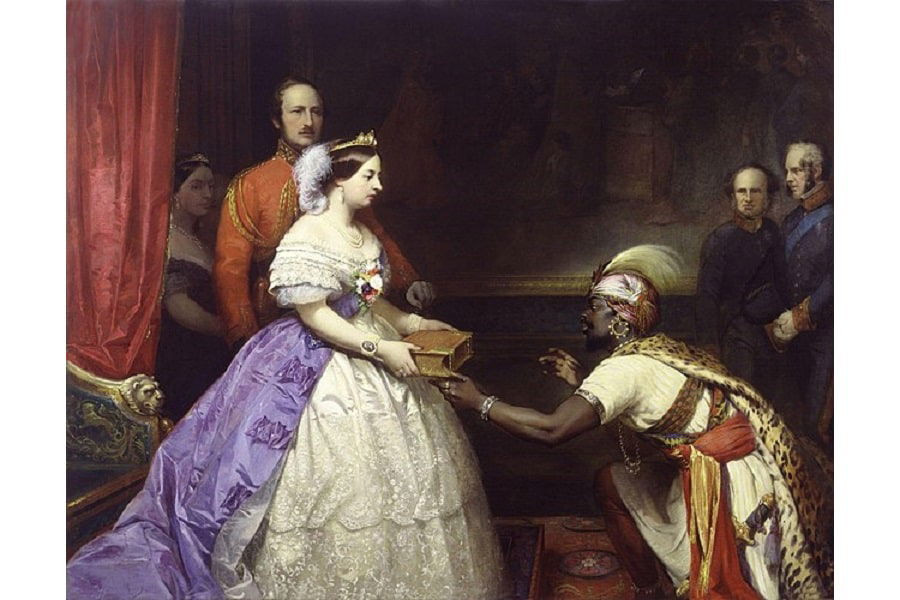
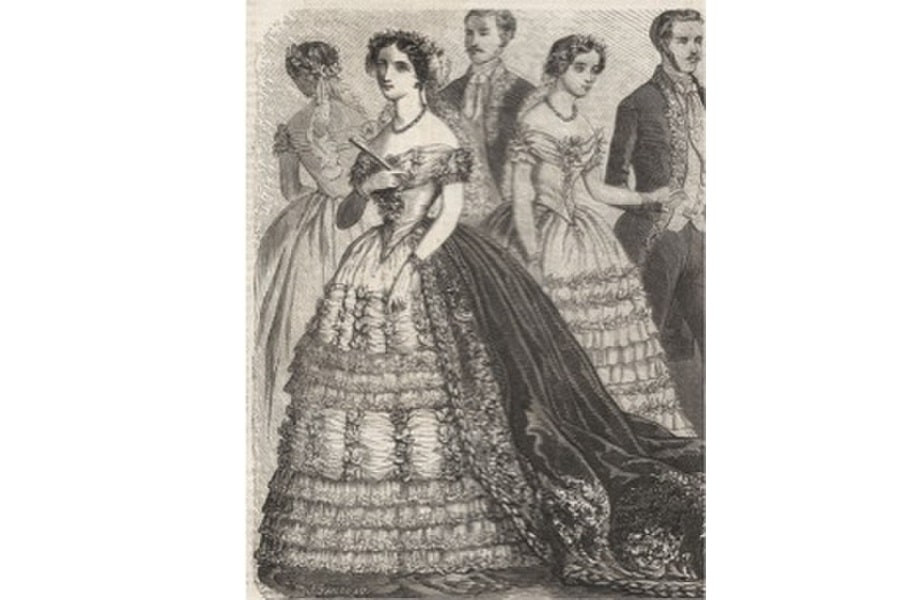
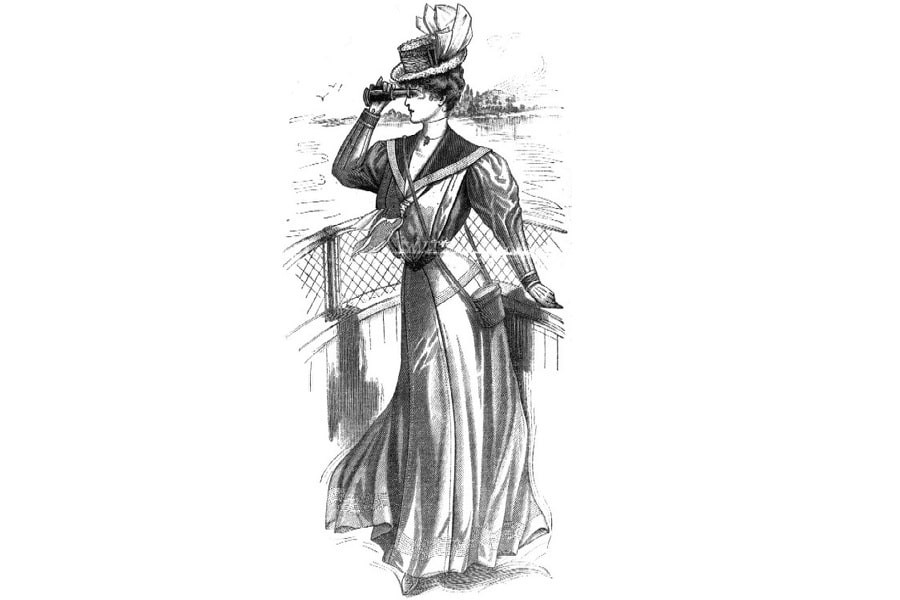

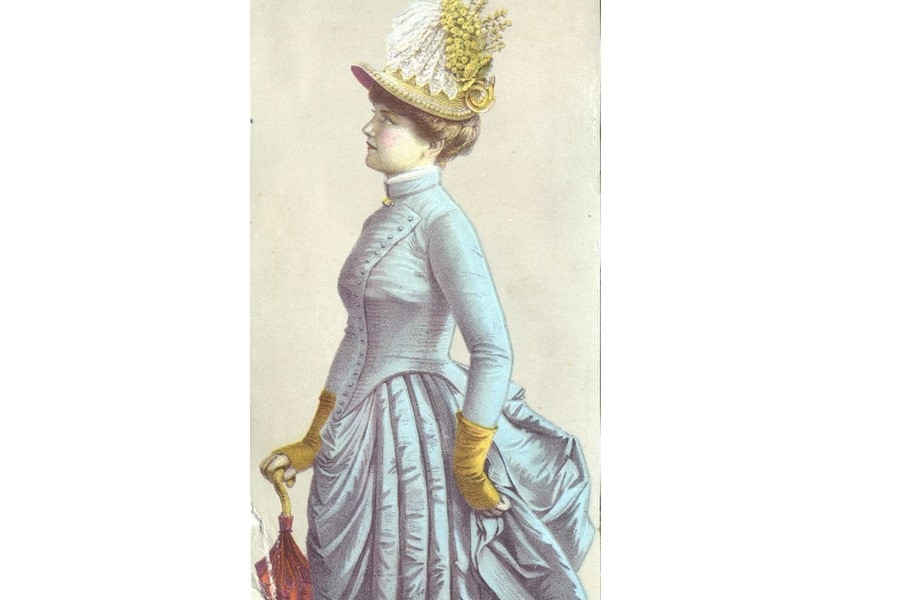
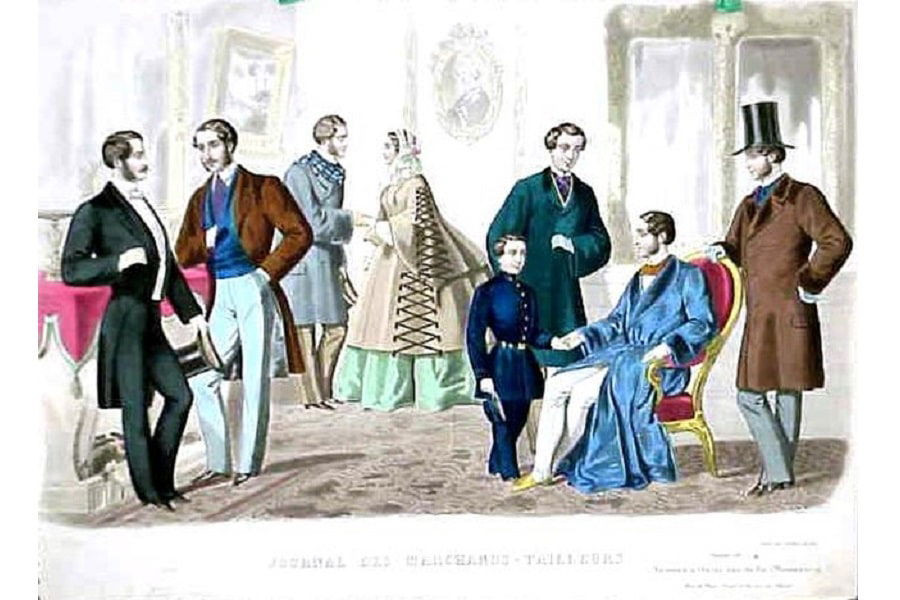
10. Frequently Asked Questions (FAQs)
10.1 What is Victorian Era Fashion?
Victorian era fashion encompasses the clothing styles and trends of the British Empire during Queen Victoria’s reign (1837-1901), marked by intricate details and evolving styles. The garments were used to define one’s social status.
10.2 How Did Social Class Influence Victorian Fashion?
Social class dictated fashion choices, with the upper class favoring elaborate, restrictive garments and the lower classes opting for practical, affordable clothing. The Victorians had rather lofty ideas when it came to hands.
10.3 What Role Did Technology Play in Transforming Victorian Fashion?
Technology, particularly the mass production of sewing machines and synthetic dyes, made clothing cheaper and more accessible, democratizing fashion. The style of dresses focused on flowing lines, with delicate details.
10.4 How Did Queen Victoria Influence Fashion?
Queen Victoria favored modest styles with slim waists and minimalistic designs, setting the tone for fashion trends during her reign and promoting understated elegance. In the 1840s men wore calf-length, tight-fitting, frock coats under which they wore a linen shirt and a single or double-breasted vest or a waistcoat.
10.5 What Were Key Characteristics of Men’s Victorian Era Fashion?
Key characteristics included frock coats, waistcoats, top hats, leather boots, and tweed Norfolk jackets, reflecting formality and social status. Men’s shoes throughout the era were leather boots of varying lengths and heel heights.
10.6 What Were the Ethical Considerations of Victorian Fashion?
Ethical considerations included the restrictive nature of women’s clothing and the labor practices involved in clothing production. Rational Dress Society’s Patterns.
10.7 How Can I Incorporate Victorian Elements into Modern Fashion?
Incorporate Victorian elements by adding tailored blazers, vests, dress boots, and accessories like pocket watches or bow ties to modern outfits. According to research from the Fashion Institute of Technology (FIT), in July 2025, P provides Y: garments were used to define one’s social status.
10.8 What Was the Significance of Hats in Victorian Fashion?
Hats were essential accessories, with different types for various occasions, often elaborately decorated with satin flowers, ribbons, bows, and feathers. Hats were perhaps the most important accessory worn by Victorian women.
10.9 How Did Victorian Fashion Influence Contemporary Design?
Victorian fashion continues to influence contemporary design through its emphasis on tailored silhouettes, luxurious fabrics, and intricate embellishments, inspiring modern designers. Queen Victoria presenting a Bible in the Audience Chamber at Windsor by Thomas Jones Barker.
10.10 Where Can I Learn More About Victorian Fashion?
Explore reputable fashion history resources, museum collections, and historical archives to deepen your understanding of Victorian fashion. Address: 227 W 27th St, New York, NY 10001, United States. Phone: +1 (212) 217-5800. Website: mens-fashion.net.
Ready to explore more about historical fashion and incorporate timeless elegance into your wardrobe? Visit mens-fashion.net for the latest articles, style guides, and expert advice on men’s fashion. Don’t miss out on the opportunity to elevate your style with inspiration from the Victorian era!